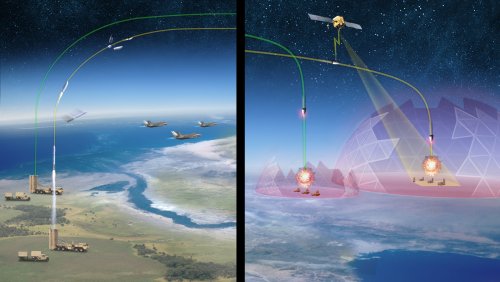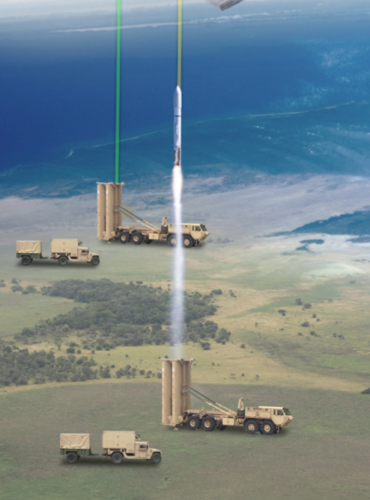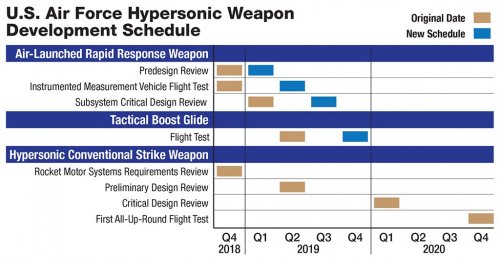- Joined
- 3 June 2011
- Messages
- 17,897
- Reaction score
- 10,978
Just trying to keep them straight. So we have (pulled from a couple different articles recently posted):
1. AGM-183A - Air-Launched Rapid Response Weapon (ARRW). "The ARRW, like many of the emerging threats, is an air-launched, rocket-boosted unpowered hypersonic glider. To be developed under a $480 million initial contract, potentially worth $780 million including early production through 2023, the ARRW work is an extension to Lockheed’s pre-existing DARPA contract under which it is building the virtually identical Tactical Boost Glide (TBG) demonstrator." Lockheed Martin Missiles and Fire Control
2. Hypersonic Conventional Strike Weapon (HCSW). The HCSW is a solid-rocket-powered, GPS-guided missile, and is targeted at initial operational capability on existing combat aircraft in fiscal 2022. Lockheed Martin Space Systems
3. Hypersonic Air-breathing Weapon Concept (HAWC). A scramjet-powered missile demonstrator similar in concept to the Air Force Research Laboratory/Boeing X-51A scramjet-powered vehicle that exceeded Mach 5 in a 2013 flight test. Both Lockheed Martin Skunk Works and Raytheon
4. Raytheon, which is partnered with Northrop Grumman Innovation Systems (formerly Orbital ATK) on the scramjet for HAWC, is also in final negotiations with DARPA to develop and test a TBG glide demonstrator. Raytheon’s newest work is believed to be supporting DARPA development of a ship-launched TBG for the U.S. Navy. In July, Lockheed was awarded a $40.5 million Navy Hypersonic Booster Technology Development (HBTD) contract, also believed to be related to this effort.
5. Another one of the projects in the Technology Transition Program is the Advanced Full Range Engine (AFRE), which aims to demonstrate a hybrid propulsion system that would utilize a traditional turbine engine and transition to a Dual Mode Ramjet (DMRJ) for hypersonic travel. Ground tests are planned for 2019 or 2020. This is a joint effort between DARPA and the National Aeronautics and Space Administration (NASA).
6. The Army and Navy are also working on developing hypersonic capabilities. The Army is working with DARPA on studying a ground-launched capability for hypersonic boost glide weapons through the Operational Fires project. This effort was funded at $6 million in FY18 and $50 million in the FY19 request. Operational Fires will also leverage work done on the Air Force TBG program. The Army was previously conducting work on the Advanced Hypersonic Weapon. A successful flight test was conducted in November 2011, but an August 2014 flight test failed due to a problem with the booster rocket used to launch the glide vehicle.
7. The Navy was tasked with a follow-on test using a downsized hypersonic vehicle. Downsizing provides the Navy with the ability to analyze possible future ship-launched capabilities. The Navy's Strategic Systems Programs office conducted this test in October 2017, dubbed Flight Experiment-1. A rocket carrying the glide vehicle was launched from Hawaii, after which the glide vehicle flew more than 2,000 miles in about 30 minutes. Other details of the test were classified.
8. In addition to the ARRW, HCSW, TBG, and HAWC, Lockheed's "Skunk Works" is believed to still be working on the High Speed Strike Weapon, which sources say is a tactical missile in the Mach 3-plus category that resembles its D-21 drone, which USAF launched from SR-71s and B-52s in the 1970s. The HSSW is derivative of the Revolutionary Approach to Time Critical Long Range Strike program Lockheed explored with the Navy in the early 2000s. (This sounds more like speculation as they seem to be conflating two different programs.)
1. AGM-183A - Air-Launched Rapid Response Weapon (ARRW). "The ARRW, like many of the emerging threats, is an air-launched, rocket-boosted unpowered hypersonic glider. To be developed under a $480 million initial contract, potentially worth $780 million including early production through 2023, the ARRW work is an extension to Lockheed’s pre-existing DARPA contract under which it is building the virtually identical Tactical Boost Glide (TBG) demonstrator." Lockheed Martin Missiles and Fire Control
2. Hypersonic Conventional Strike Weapon (HCSW). The HCSW is a solid-rocket-powered, GPS-guided missile, and is targeted at initial operational capability on existing combat aircraft in fiscal 2022. Lockheed Martin Space Systems
3. Hypersonic Air-breathing Weapon Concept (HAWC). A scramjet-powered missile demonstrator similar in concept to the Air Force Research Laboratory/Boeing X-51A scramjet-powered vehicle that exceeded Mach 5 in a 2013 flight test. Both Lockheed Martin Skunk Works and Raytheon
4. Raytheon, which is partnered with Northrop Grumman Innovation Systems (formerly Orbital ATK) on the scramjet for HAWC, is also in final negotiations with DARPA to develop and test a TBG glide demonstrator. Raytheon’s newest work is believed to be supporting DARPA development of a ship-launched TBG for the U.S. Navy. In July, Lockheed was awarded a $40.5 million Navy Hypersonic Booster Technology Development (HBTD) contract, also believed to be related to this effort.
5. Another one of the projects in the Technology Transition Program is the Advanced Full Range Engine (AFRE), which aims to demonstrate a hybrid propulsion system that would utilize a traditional turbine engine and transition to a Dual Mode Ramjet (DMRJ) for hypersonic travel. Ground tests are planned for 2019 or 2020. This is a joint effort between DARPA and the National Aeronautics and Space Administration (NASA).
6. The Army and Navy are also working on developing hypersonic capabilities. The Army is working with DARPA on studying a ground-launched capability for hypersonic boost glide weapons through the Operational Fires project. This effort was funded at $6 million in FY18 and $50 million in the FY19 request. Operational Fires will also leverage work done on the Air Force TBG program. The Army was previously conducting work on the Advanced Hypersonic Weapon. A successful flight test was conducted in November 2011, but an August 2014 flight test failed due to a problem with the booster rocket used to launch the glide vehicle.
7. The Navy was tasked with a follow-on test using a downsized hypersonic vehicle. Downsizing provides the Navy with the ability to analyze possible future ship-launched capabilities. The Navy's Strategic Systems Programs office conducted this test in October 2017, dubbed Flight Experiment-1. A rocket carrying the glide vehicle was launched from Hawaii, after which the glide vehicle flew more than 2,000 miles in about 30 minutes. Other details of the test were classified.
8. In addition to the ARRW, HCSW, TBG, and HAWC, Lockheed's "Skunk Works" is believed to still be working on the High Speed Strike Weapon, which sources say is a tactical missile in the Mach 3-plus category that resembles its D-21 drone, which USAF launched from SR-71s and B-52s in the 1970s. The HSSW is derivative of the Revolutionary Approach to Time Critical Long Range Strike program Lockheed explored with the Navy in the early 2000s. (This sounds more like speculation as they seem to be conflating two different programs.)



